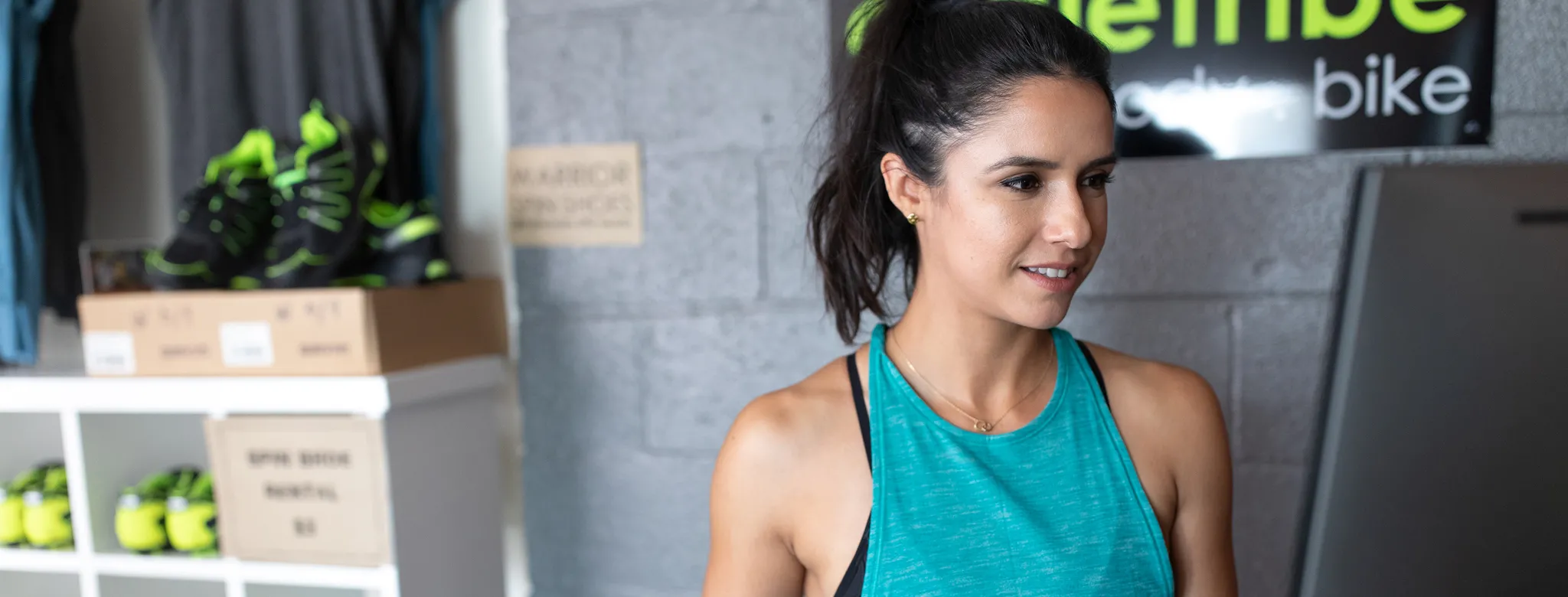
5 Expert Tips to Use Facebook Ads for Your Fitness Business
Last updated: June 23, 2025
Whether you're a new or seasoned fitness studio owner, connecting with your target audience can be challenging. It may take some trial and error, but refining your marketing strategies can help you build your client base. This is where social media, particularly Facebook ads for gyms become invaluable for connecting with current and prospective customers.
Why use Facebook for fitness ads?
More than 2 billion people use Facebook daily, making it the world's most popular social media network and the third most visited website (after Google and YouTube). These factors make it the perfect platform for fitness center advertising.
Facebook advertising is a hyper-targeted way of getting the word out about your gym or fitness studio and reaching your ideal customer on social media. The best part: Facebook ads are relatively inexpensive—especially when compared to more traditional advertising outlets.
Are you ready to master your fitness center or gym membership ads? We asked several of our Mindbody Certified Consultants for helpful tips and insights from some of their best fitness ads—and they delivered. So whether you've just started experimenting with Facebook marketing or have been running ongoing campaigns, keep these five expert tips in mind when ramping up your Facebook ad strategy:
- Micro-target your audience
- Focus your ad content
- Use the Facebook pixel to your ad-vantage
- Prioritize video-centered ads
- Bring in the experts
1. Micro-target your audience
Targeting your Facebook marketing efforts to anyone and everyone can be tempting. However, Mindbody Certified Consultant and fitness marketing expert Paul Hickey suggests doing just the opposite: "A good place to start is by creating a profile of what your 'ideal' client looks like and de-constructing from there, to eventually build a profile with numerous attributes, i.e., healthy living interest, nutrition, running, fitness, purchases online regularly, eco-friendly, etc.
Aligning these attributes with the goals and beliefs of your business is a form of micro-targeting your desired, relevant audience." According to Paul, the more specific, the better. Otherwise, you'll simply waste marketing spend on prospects that aren't likely to convert into gym members.
Paul successfully created the ad below for a fitness business using his micro-targeting technique. This ongoing ad promotes the business and drives website traffic with a "rolling" daily budget of €3. It targets individuals living in Dublin who are interested in Pilates, health and wellness, physical fitness, and yoga. To date, it's reached over 18,000 people with over 2,000 link clicks (of which 1,770 were "unique clicks") to the Pilates Performance website.
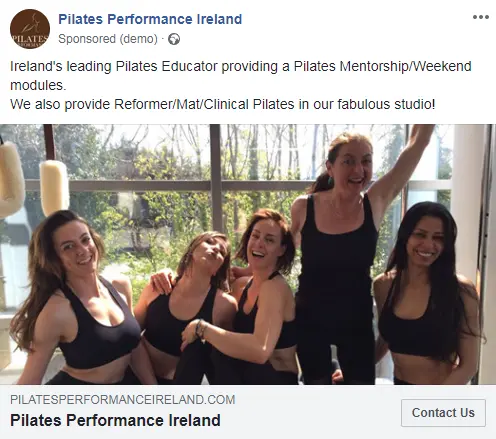
2. Focus your ad content, too
Like micro-targeting your target demographic, your ad should be relevant to your marketing audience. Mindbody Certified Consultant and fitness marketing expert Connie Holen advises, "Get specific with your offers and promotions. When you create packages that help people reach specific goals, it becomes a lot easier to focus your advertising budget on the people most likely to respond."
For example, Connie created the fitness ad below targeting newly engaged, 18-35-year-old women living within ten miles of the Pilatesmith studio. With a clear value proposition, eye-catching visual, and focused messaging sent to a narrow target market, her strategy is working—with over 90 landing page visits in just a few days!
Bonus Tip: Use the "Audiences" feature within Facebook Ads Manager to create "Saved Audiences" based on demographic and interest data ahead of time. Once they're built, you'll save time creating ads in the future.
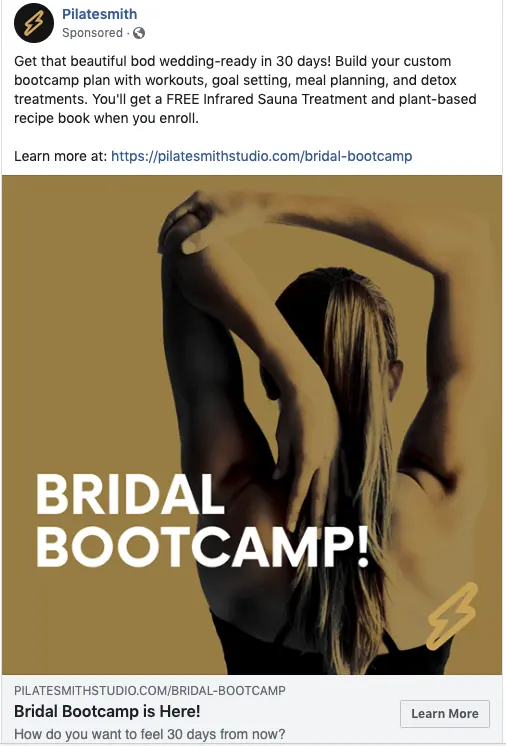
Bonus Tip: Use Facebook's Dynamic Creative feature, which automatically split tests and delivers the highest-performing combinations of your ad creative, including images, videos, titles, descriptions, and call-to-action (CTA) buttons. Pay attention to your top performing combos and repeat for future ads.
3. Use Meta Pixel to your ad-vantage
Meta Pixel is a powerful piece of code that you can easily add to your website to take Facebook marketing efforts to the next level. It tracks visitor behavior, like when someone views your website, visits a certain page, or takes a particular action–like buying a class package. Once added to your website, you can create "Custom Audiences" to retarget visitors based on set criteria.
Connie implemented the ad below for another studio with the goal of sending retargeted traffic to the yoga studio's intro offer page to increase new member sign-ups. She created a custom audience of people who had visited the studio's website within the last 10 days but excluded current Mindbody clients.
Why did it work, according to Connie? "Focus! The ad follows up with potential clients who have some level of awareness of the studio already, shares a relevant testimonial and promotes the intro offer." With over fourteen intro offer sales and $500 in additional revenue earned from just one Facebook ad, this technique is worth trying for your studio or gym.
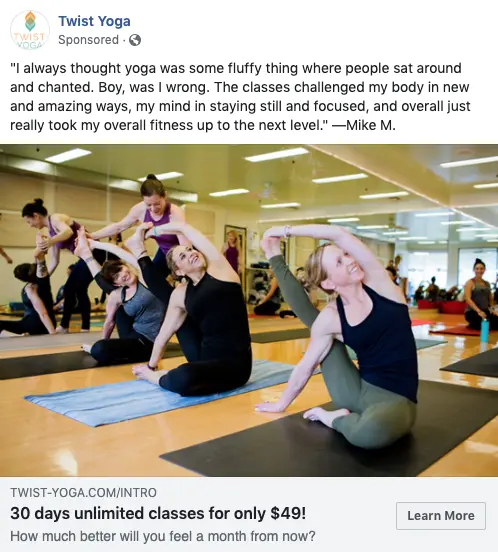
Bonus Tip: Diversify your fitness ad strategy and use both "Saved" (interest and demographic-based) and "Custom" audiences (using your website pixel) to make sure you're targeting prospective customers at each stage of their journey. Connie suggests, "Retargeting ads like this one can effectively close the loop on warm leads to increase sales. However, this tactic works best with other promotions that will drive initial traffic to the studio's website."
4. Prioritize video-centered ads
Videos are an attention-grabbing way customers can learn about your brand. According to Paul Hickey, "More and more I am tending to video-based Facebook advertising."
Paul shared the video-based ad, below, to drive sales for a spring offer using defined target audience criteria. The Pilates ad performed well, reaching over 12,000 over four days with a defined budget of €75, a cost of €0.02 cents per view, and 42 unique link clicks.
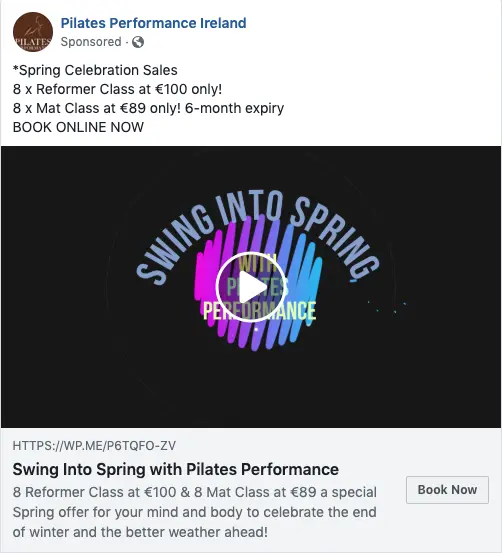
Bonus Tip: Keep videos short and to the point (fifteen seconds or less), and don't require volume for those scrolling without sound. Because users are often scrolling quickly, and on mobile devices, it's important to customize your video advertising efforts accordingly.
5. Bring in the experts
Leveraging Facebook ads can be essential to standing out in a competitive market; however, it can take a lot of time and effort to D.I.Y. Mindbody Consultant KK Hart says, "Consistently, I find that when clients run their own digital ads, they run into persistent issues such as overspending, lacking clarity on goals, no measurements to define success, and overall not being able to be strategic to reach their target market."
The lesson here: If you've implemented the tips above, and aren't finding the success you're looking for, it may be worth bringing in additional expertise. If you do, look for someone who is both an expert in the fitness industry and has vast experience in strategic digital and social media marketing.



